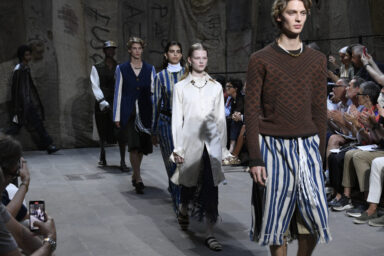When Palazzo Strozzi, in Florence, organises an exhibition, there is usually a huge response. If the protagonist is Jeff Koons, one of the most brilliant living artists, success is guaranteed. It is no coincidence, then, that just ten days after its opening, the temporary exhibition Shine has already recorded record numbers, with over 15,000 visitors. But are we sure that the success of a cultural initiative is only measured by the queues at the box office?
Text by: Gianmarco Gronchi
Editing by: Domenico Costantini
First of all, we can say that Shine, in itself, is a spectacular exhibition. The Koons’ works exhibited, which essentially cover the entire career of the American artist, are by their aesthetic nature extremely Instagrammable. They are flashy, seductive works that lend themselves to the social game and encourage people to take pictures. Koons has always been interested in the concept of the perception of art within popular mass culture, and the age of social media seems to be congenial to his artistic career. It is therefore certain that Shine will manage to get incredible media coverage, including through reposts by the visitors, in a spontaneously self-sustaining publicity process.

Jeff Koons, Hulk (Tubas) (det.), 2004-2018. Collection of the artist. © Jeff Koons
If we are certain that the Florentine event will succeed in conquering the Facebook and Instagram homepages of a large number of people, we also believe that the exhibition is rather weak from a critical and curatorial point of view. Curated by Arturo Galansino and Joachim Pissarro and on view until 30 January 2022, the Koons exhibition revolves around the concept of “shine”, interpreted according to the German term Schein, which is used to indicate appearance or what we perceive with our senses. Koons’s work is thus re-read in the light of the aesthetics of splendour, in a journey in which appearance is compared with reality. The theme has received wide attention within Western culture and certainly “shine” could be a perfect metaphor not only for Koons’ art, but also for the society in which we live. Visiting the exhibition, however, we had the impression that this theme was just a pretextual reason for a string of works that will surely be a social media success, but without offering a conceptually articulated key to interpretation that went beyond an easy visual fascination. It is no coincidence that the chronological order jumps around, with the early works placed in the rooms following those with works created in the 1980s. And the visitor, unable to follow the natural evolution of the artist, finds himself forced to submit to the arbitrary choices of the curators.

Jeff Koons, Metallic Venus (det.), 2010-2012, FABA – Fundación Almine y Bernard Ruiz-Picasso para el Arte. © Jeff Koons, Photo: Marc Domage / Courtesy Almine Rech Gallery
The biggest problem with the exhibition, however, is precisely the reading of Koons that is offered to the visitors. The few and vague introductory panels offer some information about Koons’ love of nature, his fascination with the world of popular images, the influence of Duchamp and his relationship with art history. Very little, however, emerges of the artist’s provocative attitude. Not a single mention is made of the sequence of statues depicting Koons during his sexual intercourse with the famous porn star Cicciolina, his partner between 1991 and 1992. There is no trace of the profound sense of disillusionment and nihilism that permeates the balloon statues, just as there is no explanation of how Koons constantly seeks to undermine the convictions of modern society through a ruthless and disturbing irony. Baudrillard, the famous French postmodern philosopher, spoke of simulacra, of empty signs that refer to nothingness, to an absence.

Jeff Koons, Gazing Ball (Centaur and Lapith Maiden), 2013. Courtesy Marco Voena. © Jeff Koons
Koons’s works, far from being nice reinterpretations of banal objects, could be the distressing simulacra of our reality: a vacuous reality, emptied of all meaning and value. But this is not said in the exhibition. Only in the catalogue is there any mention of the philosophical and conceptual universe that animates Koons’ research. In the rooms, however, the viewer will find it hard to place the artist in the context of the 1980s and 1990s, which saw him emerge as one of the most original and uncomfortable interpreters of our time.

Jeff Koons, Dolphin (det.), 2002, The Sonnabend Collection Foundation. © Jeff Koons
The Jeff Koons that emerges from the exhibition currently running in Florence is a docile, likeable and tenuous figure, purified of his provocative and challenging charge. Contemporary masterpieces such as Rabbit or the Balloon Dog (Red) are not enough to save an exhibition that lacks courage.

Jeff Koons, Balloon Dog (Red) (det.), 1994-2000, Private collection. © Jeff Koons
It is yet another missed opportunity to quench the thirst for knowledge that is now stronger than ever after the pandemic. Economic success is assured and perhaps Koons himself will be pleased. However, rather than referring to the American artist’s works, the “shine” that gives the exhibition its title seems to refer to the brightness that dazzles viewers. A seductive and spectacular brilliance, but one that fails to mask the shortcomings of an exhibition that is sure to be a success, but of little value.



